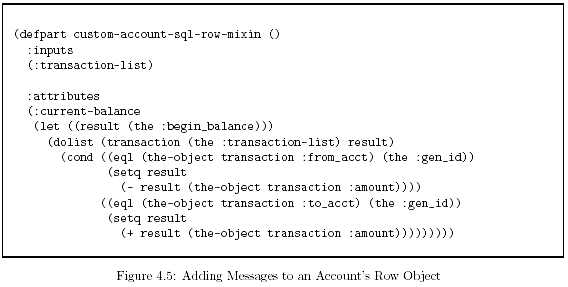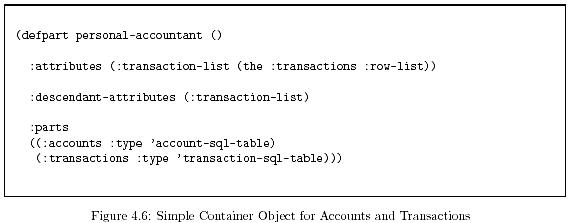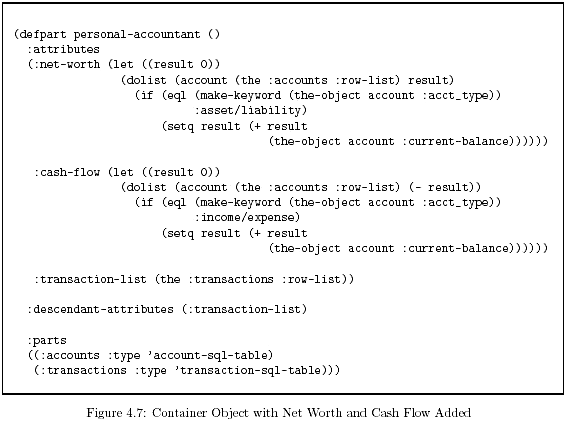
Chapter 4 CL as a CASE tool
In the following two chapters, we will illustrate a rudimentary web-based Personal Accounting Application, complete with SQL database table definitions and User Interface. We will implement this application in less than 100 lines of code, using CL and a simple CASE-like Macro extension language embedded in CL.
First, we will
describe the Macro language, which allows us to define Object Classes, their
Methods, and their relationships in a simplified, concise manner. This language
captures many of the central concepts of a general-purpose "Object
modeling" language such as the Unified Modeling Language (UML), with the
crucial difference being that the Object model is directly executable as an
application.
In the next
chapter, we will layer an HTML-based web user interface on top of the Object
model, making use of Franz Inc.'s "AllegroServe" (CL-based web server)
together with their "HTMLgen" (HTML generation system).
The language
described in this chapter allows the developer to work using an Object-oriented
approach called the message-passing paradigm, which is
somewhat simplified (and limited) compared to what pure CLOS can do. However,
for some types of problems, working in the Message-passing style is sufficient
and appropriate, and can simplify the programming process. Remember, when we use
Macro extensions on top of CL, we are working in a superset of CL, so we do
not give up any functionality - we always have the option of dropping back into
pure CLOS or CL.
In the
Message-passing paradigm of Object-oriented programming, Methods "belong"
to Classes - that is, the Methods of a Class can be defined right along with
the Class definition, as in Java or C++. This is not possible in pure CLOS,
since a CLOS Method may be associated with any arbitrary number of Classes.
Methods which
"belong" to particular Classes are also known as messages, thus the term
"Messagepassing."
In addition to implementing a Message-passing style, the Macro extension we illustrate in this chapter also implements some knowledge base features, which mainly consist of caching, dependency tracking, and a non-procedural style of programming.
Caching means that the return-value of a call to a Method (Message) is automatically "memoized" by the system, so that if the Method is called again during the same running session, the system can directly return the value, and does not have to do the actual computation again.
Dependency Tracking is a necessary complement to Caching - this feature allows the system to detect if a cached value depends on another value somewhere else in the system. This way, if the "depended-upon" value is modified ("bashed," in KB parlance), then the cached value is known to be stale and must be recomputed (and re-cached) the next time it is demanded.
Non-procedural refers to a style of programming, also known as declarative programming, in which the programmer need not be concerned with the order of evaluation, i.e. there is no explicit "begin" and "end" to a program. There is just a high-level Object model which specifies what the solution to a problem is, not procedurally how the problem is to be solved. The language handles the details of exactly which Methods to call, and when.
This general
concept of a Knowledge Base has seen a multitude of implementations, mainly in CL.
An example of a successful commercial implementation is The ICAD System® from Knowledge Technologies
International, whose Allegro CL-based language is known as the ICAD Design Language,
or ICAD/IDL. ICAD/IDL is specifically
geared towards mechanical engineering and geometric work, and so it has very
deep and broad support for geometric Objects (wireframe, surfaces, and solids),
a graphical user interface with geometric display capability, as well as
integrations with various Computer-Aided Design (CAD) systems, built on top of
the basic KB Object description language.
An example of
an open-source KB language implementation is the General-purpose Declarative Language,
or GDL, which also implements a cached, dependency-tracked, message-passing
programming style. GDL is intended as a teaching tool and as a substrate for implementing
certain kinds of Object-oriented applications in Common Lisp.
ICAD/IDL is
available from Knowledge Technologies International at
http://www.ktiworld.com
as part of
their Knowledge Based Organization (KBO) suite. GDL is available in unsupported
form through Sourceforge at
http://www.sourceforge.net/projects/gdl/
and in a
supported package form from Genworks International® at
http://www.genworks.com
The Personal Accounting example presented in this and the next chapter should function similarly with either ICAD/IDL or GDL.
Defpart is the basic
Macro for defining Classes in IDL and GDL. The original meaning of "part" refers
to physical geometric parts, but here the meaning is extended to include any
kind of Functional Object. A part definition (Defpart) maps directly into a
Lisp Class definition.
The defpart Macro takes
three basic arguments:
Here are descriptions of the most common keywords making up the Specification-plist:
Inputs specify
information to be passed into the Object instance when it is created.
Attributes are really
cached Methods, with expressions to compute and return a value.
Parts specify other
Instances to be "contained" within this instance.
Methods are (uncached) Methods "of" the Defpart, and can also take other non-specialized arguments, just like a normal Function.
Figure 4.1 shows a simple example, which contains two Inputs, :first-name and :last-name, and a single Attribute, :greeting. As you can see, a defpart is analogous in some ways to a defun,

where the
Inputs are like arguments to the Function, and the Attributes are like
return-values. But seen another way, each Attribute in a defpart is like a
Function in its own right.
The referencing
Macro "the" shadows CL's "the" (which is a seldom-used type declaration operator). "The" in IDL
and GDL is a Macro which is used to reference the value of other
Messages within the same Defpart or within contained Defparts. In the above
example, we are using "the" to refer to the values of the Messages
(Inputs) named :first-name and :last-name.
Once we have defined a Defpart such as the example above, we can use the constructor Function make-part in order to create an instance of it. This Function is very similar to the CLOS make-instance Function. Here we create an instance of hello with specified values for :first-name and :last-name (the required Inputs), and assign this instance as the value of the Symbol mypart:
GDL-USER(16):
(setq mypart
(make-part 'hello :first-name "John"
:last-name
"Doe"))
#<HELLO @
#x218f39c2>
As you can see, the return value is an Instance of Class hello. Now that we have an Instance, we can use the Macro the-object to send Messages to this Instance:
GDL-USER(17):
(the-object mypart :greeting)
"Hello,
John Doe!!"
The-object is similar to the, but as its
first argument you must give an expression which evaluates to a part Instance. The, by contrast,
assumes that the part instance is the lexical variable self, which is
automatically set within the lexical context of a Defpart.
For
convenience, you can also set self manually at the CL Command Prompt, and use the instead of the-object for
referencing:
GDL-USER(18):
(setq self
(make-part 'hello :first-name "John"
:last-name
"Doe"))
#<HELLO @
#x218f406a>
GDL-USER(19):
(the :greeting)
"Hello,
John Doe!!"
In actual fact, (the ...) simply expands into (the-object self ...).
The
"Parts" keyword specifies a List of "contained" Instances, where each
instance is considered to be a "child" part of the current part. Each
child Part is of a specified Type, which itself must be defined as a Defpart
before the child part can be instantiated.
Inputs to each
instance are specified as a Plist of Keywords and Value expressions, spliced in
after the part's name and type specification, which must match the Inputs
protocol of the Defpart being instantiated. Figure 4.2 shows an example of a
Defpart which contains some Parts. In this

example, hotel and bank are presumed to be already (or soon) defined as Defparts themselves, which each answer the :water-usage Message. The reference chains:
(the :hotel :water-usage)
and
(the :bank :water-usage)
provide the
mechanism to access Messages within the child part Instances.
These child
parts become instantiated on demand, meaning that the first time these instances
or any of their Messages are referenced, the actual instance will be created and cached for
future reference.
Parts may be quantified, to specify, in effect, an Array or List of part Instances. The most common type of Quantification is called :series quantification. See Figure 4.3 for an example of a Defpart

which contains
a quantified set of Instances representing U.S. presidents. Each member of the
quantified set is fed inputs from a List of Plists, which simulates a
relational database table (essentially a "List of Rows").
Note the
following from this example:
Now that we have a basic overview of the language, let's examine some of the Objects required to implement a rudimentary Personal Accounting Application. The Application is expected to keep track of Accounts and Transactions, and to compute Balances, Cash Flows, etc. The Accounts will be Objects which answer the following Messages:
The Transactions represent movements of money from one account to another. Therefore they are Objects which must answer the following Messages:
Now let's see how these Objects come together in order to compute the desired results.
Since this is
largely a database application, we can start by looking at which Messages in our
two Defparts might represent columns in a database table:
A basic
financial Account should store its Name, Description, Account Number, Account
Type, and Beginning Balance. Its Current Balance is computed (derived)
information and is not required to be stored. A Transaction does not contain
derived information for our purposes. All its Messages are basically columns in
a database table.
So let us start
by defining some database Objects. Because database table definition requires some
datatype information to be specified in advance, and because we would like to
produce more than one Defpart to represent each table, we will use a special
definition syntax for database tables.
We have
prepared the simple Macro deftable for this purpose, as seen in Figure 4.4. As
you can see, deftable accepts a description of an SQL-style database table. If you are familiar
with Standard Query Language (SQL), you will recognize the data types in the
above definitions, e.g. varchar2 for character strings.

Deftable then processes
the description into two Defparts: one representing an instance of the table
itself, and another representing the Rows of the table instance. The
"table" Defpart will contain a quantified set of "Row" Instances. The
Values in the individual Rows are represented by ordinary Messages supported by
the "Row" Instances. The Table Object supports Methods for Inserting and
Deleting Rows from the table, and the Row Object supports Methods for Updating the
values in each Row. (Methods, in this context, are Messages which take
arguments in addition to the implicit self argument present in all
Messages).
As a side-effect,
the Deftable Macro also communicates through a database connection Object to a live SQL
database, and either
This second of the possible side-effects represents a convenient way to do schema evolution on the live tables in the database.
Now we can extend the Account definition to compute the current balance. For this purpose, we can take advantage of the fact that the "Row" Object generated by deftable will have been defined to inherit from a (initially empty) custom Class, or "mixin." If the SQL table is named ACCOUNT, the Defpart representing Rows in this table will be named account-sql-row, and the Custom Mixin will be named custom-account-sql-row-mixin. Therefore, we can redefine the custom-account-sql-row-mixin Class as shown in Figure 4.5 . Instances of the account-sql-row will now answer the :current-balance Message. The Message is being computed as follows:

Note also the following:
Now that we
have some basic persistent building blocks, let us put together a simple
application. At this point the only user interface to the application will be
the CL Command Prompt. In the next chapter, we will attach a simple web-based
interface.
At this point
we need a "container" Object to hold our collections of Accounts and
Transactions. Figure 4.6 shows a first version of such an Object definition.
This part has one Object for Accounts

and one Object
for Transactions. It also computes :transaction-list as the List of all rows
from the Transactions table, and specifies this Message as descendant.
Descendant-attributes provides a mechanism for ensuring that this Message will
be available in all descendant parts from the part in which it is defined, as if it had been
explicitly passed as an Input into each of these parts. This way, we are
ensuring that :transaction-list will be available in our Account Row Objects
(children of the :accounts), since our custom-mixin requires : transaction-list as an Input.
Descendant-attributes
should be used sparingly, as their overuse can lead to confusing situations (i.e.
Messages coming from unexpected places in the Object hierarchy).
Now, we will
add two Messages to our container, one to compute Net Worth and one to compute Cash
Flow. Net Worth is the sum of Balances of all accounts of type
"Asset/Liability," and Cash Flow is the negation of the sum of Balances of
all accounts of type "Income/Expense" (the sign is reversed so that Income
appears positive and Expenses appear negative).
Figure 4.7
shows our personal-accountant Defpart with these two Messages added. Each Message
is computed in basically the same manner: a dolist is used to
iterate through all accounts, accumulating the balance of each account of the
applicable type into the result.
Now our
application consists of one root Object, personal-accountant, with two
child Objects, one for the Accounts and one for the Transactions. These three
Objects answer Messages as follows:
At this point we have just a CL Command Prompt interface to the system. For purposes of illustration, we will enter two Rows into the Accounts table and a transaction into the Transactions table, then query the application for some of our supported Messages:
GENACC(20):
(setq self (make-part 'personal-accountant))
#<PERSONAL-ACCOUNTANT
@ #x20f678e2>

GENACC(21):
(the :accounts :row-list)
NIL
GENACC(22):
(the :accounts (:insert!
(list :name "Checking"
:description
"ACME National Back Checking"
:acct_number
01
:acct_type
"asset/liability"
:begin_balance
500)))
GENACC(23):
(the :accounts (:insert!
(list :name "Utilities"
:description
"Home Utilities -- electric, etc."
:acct_number
55
:acct_type
"income/expense"
:begin_balance
0)))
The two calls to the :insert! Method each added a Row to the database, as well as updating the current Objects so that any dependent Objects or Messages will see the change immediately:
GENACC(24):
(the :accounts :row-list)
(#<ACCOUNT-SQL-ROW
@ #x20f67954> #<ACCOUNT-SQL-ROW @ #x20f67982>)
GENACC(25):
(mapsend (the :accounts :row-list) :index)
(1 2)
GENACC(26):
(the :accounts (:rows 1) :current-balance)
500
GENACC(27):
(the :accounts (:rows 2) :current-balance)
0
The mapsend Function above
takes a List of Objects and sends a given Message to each of them, returning a
List of the results. The (:rows 1) and (:rows 2) syntax is a way of
referencing particular members of a quantified set.
Now let us add
a transaction, and see that it updates the relevant Messages:
GENACC(28):
(the :transactions (:insert!
(list :trans_date "25-aug-00"
:from_acct
1
:to_acct
2
:payee
"Detroit Edison"
:amount
75)))
GENACC(29):
(the :accounts (:rows 1) :current-balance)
425
GENACC(30):
(the :accounts (:rows 2) :current-balance)
75
GENACC(31):
(the :net-worth)
425
GENACC(32):
(the :cash-flow)
-75
GENACC(33):
(the :transactions (:insert!
(list :trans_ date "25-aug-00"
:from_acct
1
:to_acct
2
:payee
"Michcon Gas"
:amount
125)))
GENACC(34):
(the :accounts (:rows 1) :current-balance)
300
GENACC(35):
(the :accounts (:rows 2) :current-balance)
200
GENACC(36):
(the :cash-flow)
-200
GENACC(37):
(the :net-worth)
300
So our main Messages are working, through a simple command-line interface for now. A well-rounded personal accounting program would, of course, require certain extensions. Here are a few examples:
With a robust
Object Model, features such as these can be added and tested in an
incremental manner. We would simply add new Messages and possibly additional
Objects to our Object Hierarchy, building steadily toward the desired
functionality.
As new
"required functionality" becomes apparent (as it invariably does), our
exible and extensible Object Model stands ready to comply.
In about 45 lines
of code, we have written a basic runnable account-balancing program, including the
creation of the required SQL database tables and associated Methods for
transacting with the database. Done in pure Common Lisp (i.e. without using any
extension Macros), this application would have taken slightly more code, but
still not an unreasonable amount.
The main
objective of the example is to show what really is possible with Common Lisp by
judiciously
selecting
and/or developing some strategic extension Macros. The Defpart Macro is but one
example of how CL can automate the programming process; many other approaches
certainly exist, and others have yet to be discovered.